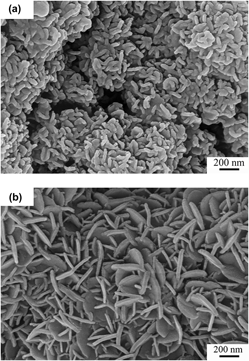Crossref Citations
This article has been cited by the following publications. This list is generated based on data provided by
Crossref.
Liu, Xianguo
Ran, Songlin
Yu, Jieyi
and
Sun, Yuping
2018.
Multiscale assembly of Fe2B porous microspheres for large magnetic losses in the gigahertz range.
Journal of Alloys and Compounds,
Vol. 765,
Issue. ,
p.
943.
Mertdinç, Sıddıka
Ağaoğulları, Duygu
and
Öveçoğlu, M. Lütfi
2018.
Mechanochemically synthesized Fe2B nanoparticles embedded in SiO2 nanospheres.
Ceramics International,
Vol. 44,
Issue. 12,
p.
14834.
Liu, Shuai
Bian, Xiufang
Liu, Jie
Wang, Junzhang
Yu, Mengchun
Yang, Yinghui
and
Fan, Runhua
2018.
A new preparation method of Fe 2 B: Generating rodlike/scale-like Fe 2 B by dealloying Fe 78 Si 9 B 13 atomized particle.
Intermetallics,
Vol. 94,
Issue. ,
p.
186.
BARIŞ, Mustafa
Şimşek, Tuncay
and
Taşkaya, Hatice
2018.
Synthesis of Fe-Fe2B catalysts via solvothermal route for hydrogen generation by hydrolysis of NaBH4.
Journal of Boron,
Zhang, Jingming
Li, Changning
Armstrong, Jason
and
Ren, Shenqiang
2019.
Eutectic melt crystallization of L10-FePt.
Chemical Communications,
Vol. 55,
Issue. 5,
p.
656.
Khoshsima, Sina
Altıntaş, Zerrin
Schmidt, Marcus
Bobnar, Matej
Somer, Mehmet
and
Balcı, Özge
2019.
Crystalline Co–Fe–B nanoparticles: Synthesis, microstructure and magnetic properties.
Journal of Alloys and Compounds,
Vol. 805,
Issue. ,
p.
471.
Verma, Piyush Chandra
and
Mishra, Suman Kumari
2020.
Synthesis of iron boride powder by carbothermic reduction method.
Materials Today: Proceedings,
Vol. 28,
Issue. ,
p.
902.
Wan, Hongliu
Liu, Xing-Wu
Qing, Ming
Liu, Jin-Jia
Zhang, Yu
Liu, Suyao
Wang, Hong
Wen, Xiao-Dong
Yang, Yong
and
Li, Yong-Wang
2020.
Insight into the magnetic moment of iron borides: theoretical consideration from the local coordinative and electronic environment.
Dalton Transactions,
Vol. 49,
Issue. 7,
p.
2168.
Mete, Busra
Peighambardoust, Naeimeh Sadat
Aydin, Samet
Sadeghi, Ebrahim
and
Aydemir, Umut
2021.
Metal-substituted zirconium diboride (Zr1-TMB2; TM = Ni, Co, and Fe) as low-cost and high-performance bifunctional electrocatalyst for water splitting.
Electrochimica Acta,
Vol. 389,
Issue. ,
p.
138789.
Altıntaş, Zerrin
Khoshsima, Sina
Schmidt, Marcus
Bobnar, Matej
Burkhardt, Ulrich
Somer, Mehmet
and
Balcı, Özge
2021.
Evolution of magnetic properties of crystalline cobalt-iron boride nanoparticles via optimization of synthesis conditions using hydrous metal chlorides.
Journal of Magnetism and Magnetic Materials,
Vol. 523,
Issue. ,
p.
167634.
KARTAL, Levent
2022.
Single Fe2B Phase Particle Production by Calciothermic Reduction in Molten Salt.
Hittite Journal of Science and Engineering,
Vol. 9,
Issue. 2,
p.
145.
Abeysinghe, Janaka P.
Kölln, Anna F.
and
Gillan, Edward G.
2022.
Rapid and Energetic Solid-State Metathesis Reactions for Iron, Cobalt, and Nickel Boride Formation and Their Investigation as Bifunctional Water Splitting Electrocatalysts.
ACS Materials Au,
Vol. 2,
Issue. 4,
p.
489.
Potanin, A.Yu
Bashkirov, E.A.
Levashov, E.A.
Loginov, P.A.
Berezin, M.A.
and
Kovalev, D.Yu
2023.
Nucleation and growth of the Fe2AlB2 MAB phase in the combustion wave of mechanically activated Fe–Al–B reaction mixtures.
Ceramics International,
Vol. 49,
Issue. 23,
p.
37849.
Dhand, Vivek
Lim, Jiseok
Bharadwaj, S.
Kim, Sanghoon
and
Rhee, Kyongyop
2023.
Sol–gel combustion derived novel ternary transition metal boride-anisotropic magnetic powders and their magnetic property.
Journal of Materials Research and Technology,
Vol. 24,
Issue. ,
p.
7219.
Igoa Saldaña, Fernando
Defoy, Emile
Janisch, Daniel
Rousse, Gwenaëlle
Autran, Pierre-Olivier
Ghoridi, Anissa
Séné, Amandine
Baron, Marzena
Suescun, Leopoldo
Le Godec, Yann
and
Portehault, David
2023.
Revealing the Elusive Structure and Reactivity of Iron Boride α-FeB.
Inorganic Chemistry,
Vol. 62,
Issue. 5,
p.
2073.
Kartal, Levent
2023.
Singe Phase Iron Boride (Fe2B) Particle Production from Pickling Wastes by One Step Carbothermic Reduction.
Journal of Sustainable Metallurgy,
Vol. 9,
Issue. 4,
p.
1660.
Mertdinç-Ülküseven, Sıddıka
Khakzad, Farnoud
Aslan, Caner
Onbasli, Kubra
Çevik, Çağdaş
İşçi, Sevim
Balcı-Çağıran, Özge
Yagci Acar, Havva
Öveçoğlu, M. Lütfi
and
Ağaoğulları, Duygu
2023.
Fe2B magnetic nanoparticles: Synthesis, optimization and cytotoxicity for potential biomedical applications.
Journal of Science: Advanced Materials and Devices,
Vol. 8,
Issue. 3,
p.
100602.
Aydemir, Duygu
Arıbuğa, Dilara
Hashemkhani, Mahshid
Acar, Havva Yagci
Balcı-Çağıran, Özge
and
Ulusu, Nuriye Nuray
2024.
Bioavailability assessment of the novel GSH-functionalized FeB nanoparticles via oxidative stress and trace element metabolism in vitro: promising tools for biomedical applications.
Journal of Nanoparticle Research,
Vol. 26,
Issue. 12,
Çelik, Ülkü Aslı
Sunar, Talha
Özyürek, Dursun
and
Gürü, Metin
2024.
Mekanokimyasal Yöntemle FeB ve Fe2B Bileşiklerinin Üretimi ve Karakterizasyonu.
Politeknik Dergisi,
Vol. 27,
Issue. 5,
p.
1789.
Chen, Guxian
Li, Hongyang
Wang, Yuqi
Ding, Yingrui
Qian, Pengsen
Zhang, Kailong
Zeng, Haibo
and
Li, Gaoran
2024.
Ultrafine Iron Boride as a Highly Efficient Nanocatalyst Expedites Sulfur Redox Electrochemistry for High‐Performance Lithium‐Sulfur Batteries.
Batteries & Supercaps,
Vol. 7,
Issue. 8,




